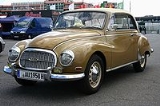
Auto Union 1000
Encyclopedia
The Auto Union 1000 was a compact
front wheel drive saloon
manufactured by Auto Union AG
between 1958 and 1963. It was the first (and in many markets the last) model branded as an Auto Union by the manufacturer since the 1930s: it replaced the paradoxically named DKW 3=6
, although the latter continued in production, reassuringly now branded as the DKW 900, for another year. The two cars were broadly similar, but the new car had its two stroke engine enlarged to 981 cc yielding a 10% - 37% (according to model) power increase.
. A three door estate version was also offered, branded as the ‘Universal’, between 1959 and 1962. For the new decade, the saloon was renamed Auto Union 1000S and received, in August 1959, an eye catching wrap around windscreen. Neither the windscreen nor the name changes entirely concealed the fact that at a time when competitor designs employed the modern ponton
, three box
form, this Auto Union’s body along with most of its technical features descended directly from that of the Zwickau
developed DKW F9 prototype of 1938. Fortunately in 1938 the front wheel drive DKW design had been an innovative one.
Appearing in 1958 was the Auto Union 1000 Sp, a low slung two seater sports car
that was produced for Auto Union by the Stuttgart
coach builders, Baur
. The fixed head version was joined in 1961 by a cabriolet. Adorned with tail fins, the stylish modern look of the car gave rise to the "baby Thunderbird" (schmalspur Thunderbird) soubriquet in the press, and belied the fact that it was, under the skin, another Auto Union 1000, albeit one with an increased compression ratio and a claimed maximum of 55 bhp to place on the road. The 1000 Sp was lower but not (assuming only two people were in the car) significantly lighter than the standard bodied saloon: a claimed maximum speed of 140 km/h (87 mph) nevertheless put its performance at the top of the range.
Fissore drew the Coupé and Spyder "1000 SE" on the basis of German "1000 Sp", but this time more elegant and it departed from the visual appearance of the Ford Thunderbird, the "Fissore Coupé" stood out with one piece front bumpers and longer wrap around bumpers in back, an alternate roof line, side louvers in the front fenders between the front wheel cut outs and doors ornated with chrome strips and an elegantly appointed interior, limited numbers of the coupé where built and are highly sought out by collectors. Licensed productions of the Coupés and Spyder where also assembled in Spain.
_1000_(registered_1965)_right.jpg) A 1000S Coupé was tested by the British The Motor
A 1000S Coupé was tested by the British The Motor
magazine in 1960 and had a top speed of 80.9 mph (130.2 km/h) and could accelerate from 0-60 mph (96.6 km/h) in 23.6 seconds. A fuel consumption of 31.5 mpgimp was recorded. The test car cost £1259 including taxes on the UK market. In the same year, the much larger Austin Westminster retailed for only £1148 in the UK, reflecting, in particular, the extent to which British automakers were still protected by import tariffs in their home market.
engine came in various states of tune. After 1960, advertised power in the saloon versions was increased to 50 bhp (37 kW). Power was delivered via a four speed manual gear box, controlled using a column mounted lever. The electrical system was a six volt one which by this time was beginning to look old fashioned.
1961 saw the introduction of the so called Clean Oil Regulator “Frischölautomatik”, a system incorporating a separate oil tank and pump to dispense the oil which, in a two stroke engine, is mixed with the fuel ahead of combustion. The stated purpose was to reduce the characteristic blue smoke emission
for which the car was known. This was to be achieved by ensuring that oil
was introduced in exactly the correct 1:40 proportion to the fuel, and the device was advertised as a way to improve engine longevity. The timing of this innovation proved unfortunate The 1962/63 winter was an exceptionally cold one in Europe. The Auto Union 1000 model experienced an unexpected increase in crankshaft
damage because the oil, its viscosity
affected by the cold weather, was unable to flow freely through the narrow feeder pipe in the carburettor.
plant produced 171,008 Auto Union 1000s during the six year model run. The pretty 1000 Sp sports version continued in production for another two years, till 1965, notching up sales of approximately 5,000 for the hard top version and 1,640 for the cabriolet.
. The older model DKW 3=6
continued in production in a slightly modified form in Brazil
until 1967, however, it was produced without modification in Santa Fé
, Argentina
until late 1969, about 30,000 copies were manufactured.
Compact car
A compact car , or small family car , is a classification of cars which are larger than a supermini but smaller than or equal to a mid-size car...
front wheel drive saloon
Automobile
An automobile, autocar, motor car or car is a wheeled motor vehicle used for transporting passengers, which also carries its own engine or motor...
manufactured by Auto Union AG
Auto Union
Auto Union was an amalgamation of four German automobile manufacturers, founded in 1932 and established in 1936 in Chemnitz, Saxony, during the Great Depression. The company has evolved into present day Audi, as a subsidiary of Volkswagen Group....
between 1958 and 1963. It was the first (and in many markets the last) model branded as an Auto Union by the manufacturer since the 1930s: it replaced the paradoxically named DKW 3=6
DKW 3=6
The DKW 3=6 was a compact front-wheel drive saloon manufactured by Auto Union AG. The car was launched at the Frankfurt Motor Show in March 1953 and sold until 1959. It was also named as the DKW Sonderklasse and, following the factory project number, as the DKW F91...
, although the latter continued in production, reassuringly now branded as the DKW 900, for another year. The two cars were broadly similar, but the new car had its two stroke engine enlarged to 981 cc yielding a 10% - 37% (according to model) power increase.
The Changes
Apart from the enlarged engine, which now provided in the base model 44 bhp, the 1000 featured the old four ring Auto Union badge across the air grill along with the ‘Auto Union’ name above it, in place of the ‘DKW’ badge that had adorned the nose of the earlier model.Body options
In addition to the two and four door saloons, there was a ‘pillarless’ coupé which shared the profile of the saloons apart from the absence of any fixed B pillarPillar (car)
Pillars are the vertical supports of the greenhouse of an automobile — known respectively as the A, B, C or D-pillar moving in profile view from the front to rear....
. A three door estate version was also offered, branded as the ‘Universal’, between 1959 and 1962. For the new decade, the saloon was renamed Auto Union 1000S and received, in August 1959, an eye catching wrap around windscreen. Neither the windscreen nor the name changes entirely concealed the fact that at a time when competitor designs employed the modern ponton
Ponton (automobile)
Ponton or Pontoon styling refers to a 1930s-1960s design genre — ultimately the precursor of modern automotive styling. The trend emerged as distinct running boards and fully articulated fenders became less common and bodywork began to enclose the full width and uninterrupted length of a car...
, three box
Three-box styling
Three-box design is a broad automotive styling term describing a coupé, sedan, notchback or hatchback where — when viewed in profile — principal volumes are articulated into three separate compartments or boxes: engine, passenger and cargo....
form, this Auto Union’s body along with most of its technical features descended directly from that of the Zwickau
Zwickau
Zwickau in Germany, former seat of the government of the south-western region of the Free State of Saxony, belongs to an industrial and economical core region. Nowadays it is the capital city of the district of Zwickau...
developed DKW F9 prototype of 1938. Fortunately in 1938 the front wheel drive DKW design had been an innovative one.
Appearing in 1958 was the Auto Union 1000 Sp, a low slung two seater sports car
Sports car
A sports car is a small, usually two seat, two door automobile designed for high speed driving and maneuverability....
that was produced for Auto Union by the Stuttgart
Stuttgart
Stuttgart is the capital of the state of Baden-Württemberg in southern Germany. The sixth-largest city in Germany, Stuttgart has a population of 600,038 while the metropolitan area has a population of 5.3 million ....
coach builders, Baur
Karosserie Baur
Baur is a Karosserie or coachbuilder in Stuttgart, Germany, which has been building BMW convertibles since the 1930s. Currently, they are the body and assembly works for IVM Automotive, a member the Ed Group...
. The fixed head version was joined in 1961 by a cabriolet. Adorned with tail fins, the stylish modern look of the car gave rise to the "baby Thunderbird" (schmalspur Thunderbird) soubriquet in the press, and belied the fact that it was, under the skin, another Auto Union 1000, albeit one with an increased compression ratio and a claimed maximum of 55 bhp to place on the road. The 1000 Sp was lower but not (assuming only two people were in the car) significantly lighter than the standard bodied saloon: a claimed maximum speed of 140 km/h (87 mph) nevertheless put its performance at the top of the range.
Fissore and Auto Union
In Argentina the 1000 was manufactured under license by IASFe (Industrias Automotriz de Santa Fe) between 1960 and 1970, the lineup consisted of the 2 and 4-door sedan, the 3-door Universal estate (station wagon), and CarrozzeriaCoachbuilder
A coachbuilder is a manufacturer of bodies for carriages or automobiles.The trade dates back several centuries. Rippon was active in the time of Queen Elizabeth I, Barker founded in 1710 by an officer in Queen Anne's Guards, Brewster a relative newcomer , formed in 1810. Others in Britain included...
Fissore drew the Coupé and Spyder "1000 SE" on the basis of German "1000 Sp", but this time more elegant and it departed from the visual appearance of the Ford Thunderbird, the "Fissore Coupé" stood out with one piece front bumpers and longer wrap around bumpers in back, an alternate roof line, side louvers in the front fenders between the front wheel cut outs and doors ornated with chrome strips and an elegantly appointed interior, limited numbers of the coupé where built and are highly sought out by collectors. Licensed productions of the Coupés and Spyder where also assembled in Spain.
Performance
_1000_(registered_1965)_right.jpg)
The Motor (magazine)
The Motor was a British weekly car magazine founded on 28 January 1903....
magazine in 1960 and had a top speed of 80.9 mph (130.2 km/h) and could accelerate from 0-60 mph (96.6 km/h) in 23.6 seconds. A fuel consumption of 31.5 mpgimp was recorded. The test car cost £1259 including taxes on the UK market. In the same year, the much larger Austin Westminster retailed for only £1148 in the UK, reflecting, in particular, the extent to which British automakers were still protected by import tariffs in their home market.
Technical
The Auto Union's 981 cc two stroke three cylinderStraight-3
A straight-three engine, also known as inline-three engine, or a triple, is a reciprocating piston internal combustion engine with three cylinders arranged in a straight line or plane, side by side....
engine came in various states of tune. After 1960, advertised power in the saloon versions was increased to 50 bhp (37 kW). Power was delivered via a four speed manual gear box, controlled using a column mounted lever. The electrical system was a six volt one which by this time was beginning to look old fashioned.
1961 saw the introduction of the so called Clean Oil Regulator “Frischölautomatik”, a system incorporating a separate oil tank and pump to dispense the oil which, in a two stroke engine, is mixed with the fuel ahead of combustion. The stated purpose was to reduce the characteristic blue smoke emission
Automobile emissions control
Vehicle emissions control is the study and practice of reducing the motor vehicle emissions -- emissions produced by motor vehicles, especially internal combustion engines....
for which the car was known. This was to be achieved by ensuring that oil
Motor oil
Motor oil or engine oil is an oil used for lubrication of various internal combustion engines. The main function is to lubricate moving parts; it also cleans, inhibits corrosion, improves sealing, and cools the engine by carrying heat away from moving parts.Motor oils are derived from...
was introduced in exactly the correct 1:40 proportion to the fuel, and the device was advertised as a way to improve engine longevity. The timing of this innovation proved unfortunate The 1962/63 winter was an exceptionally cold one in Europe. The Auto Union 1000 model experienced an unexpected increase in crankshaft
Crankshaft
The crankshaft, sometimes casually abbreviated to crank, is the part of an engine which translates reciprocating linear piston motion into rotation...
damage because the oil, its viscosity
Viscosity
Viscosity is a measure of the resistance of a fluid which is being deformed by either shear or tensile stress. In everyday terms , viscosity is "thickness" or "internal friction". Thus, water is "thin", having a lower viscosity, while honey is "thick", having a higher viscosity...
affected by the cold weather, was unable to flow freely through the narrow feeder pipe in the carburettor.
Commercial
The DüsseldorfDüsseldorf
Düsseldorf is the capital city of the German state of North Rhine-Westphalia and centre of the Rhine-Ruhr metropolitan region.Düsseldorf is an important international business and financial centre and renowned for its fashion and trade fairs. Located centrally within the European Megalopolis, the...
plant produced 171,008 Auto Union 1000s during the six year model run. The pretty 1000 Sp sports version continued in production for another two years, till 1965, notching up sales of approximately 5,000 for the hard top version and 1,640 for the cabriolet.
The end
In 1963 the Auto Union 1000 gave way in Europe to its successor, the contemporary looking DKW F102DKW F102
The DKW F102 is a car that was produced initially by German manufacturer Auto Union AG and later by Volkswagen AG after Volkswagen acquired the Auto Union brands from Daimler-Benz AG in 1964. It succeeded the Auto Union 1000 and 1000S models in 1963...
. The older model DKW 3=6
DKW 3=6
The DKW 3=6 was a compact front-wheel drive saloon manufactured by Auto Union AG. The car was launched at the Frankfurt Motor Show in March 1953 and sold until 1959. It was also named as the DKW Sonderklasse and, following the factory project number, as the DKW F91...
continued in production in a slightly modified form in Brazil
Brazil
Brazil , officially the Federative Republic of Brazil , is the largest country in South America. It is the world's fifth largest country, both by geographical area and by population with over 192 million people...
until 1967, however, it was produced without modification in Santa Fé
Santa Fe, Argentina
Santa Fe is the capital city of province of Santa Fe, Argentina. It sits in northeastern Argentina, near the junction of the Paraná and Salado rivers. It lies opposite the city of Paraná, to which it is linked by the Hernandarias Subfluvial Tunnel. The city is also connected by canal with the...
, Argentina
Argentina
Argentina , officially the Argentine Republic , is the second largest country in South America by land area, after Brazil. It is constituted as a federation of 23 provinces and an autonomous city, Buenos Aires...
until late 1969, about 30,000 copies were manufactured.
Gallery
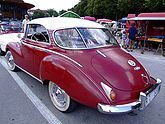 |
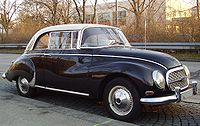 |
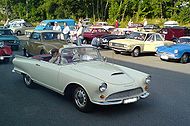 |
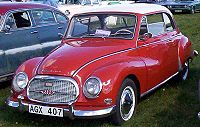 |

